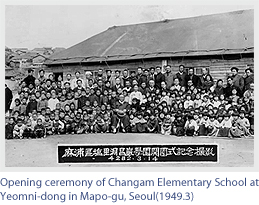

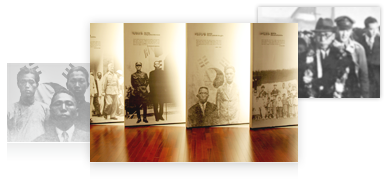
National Liberation and South-North Demarcation
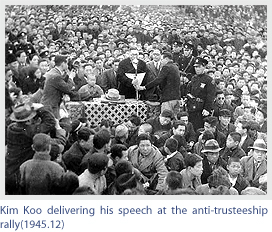 News of Japan's surrender reached Kim Koo on August 10 as he was returning home from planning a joint KIA-US advance operations into Korea. The long-awaited news came unexpectedly, but Kim Koo soon Worried that the years of preparations by the KIA to participate in the war would all come to naught. The prospect of not returning home as a victorious belligerent would also mean less a voice in Korean affairs, and the realities of the Korean peninsula that greeted him upon his return in November of 1945 reflected just such concerns; the division and occupation of the Korean peninsula by the Soviet Union and the US north and south of the 38th parallel, and news of the five-year trusteeship
News of Japan's surrender reached Kim Koo on August 10 as he was returning home from planning a joint KIA-US advance operations into Korea. The long-awaited news came unexpectedly, but Kim Koo soon Worried that the years of preparations by the KIA to participate in the war would all come to naught. The prospect of not returning home as a victorious belligerent would also mean less a voice in Korean affairs, and the realities of the Korean peninsula that greeted him upon his return in November of 1945 reflected just such concerns; the division and occupation of the Korean peninsula by the Soviet Union and the US north and south of the 38th parallel, and news of the five-year trusteeship
Anti-trusteeship Movement
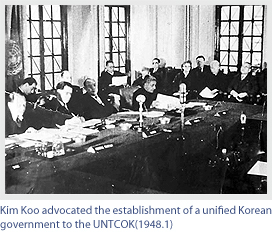 When the Moscow Tripartite Summit Meeting decided on the five-year trusteeship of Korea in December 1945, Kim Koo immediately took an anti-trusteeship position and held a large-scale anti-trusteeship demonstration on December 31. He regarded the anti-trusteeship movement as part of a secondary national independence drive. To help the anti-trusteeship movement succeed, he worked to strengthen the right-left coalition. Simultaneously, he advocated Korea's unification and opposed the establishment of separate governments in South and North Korea. To this end, he and Kim Gyu-sik carried out the South-North Political Negotiation with North Korea's Premier Kim Il-sung and Kim Du-bong of North Korea's uppermost stratum. Despite his efforts, the Korean peninsula was ideologically divided into South and North, as separate governments were established in 1948.
When the Moscow Tripartite Summit Meeting decided on the five-year trusteeship of Korea in December 1945, Kim Koo immediately took an anti-trusteeship position and held a large-scale anti-trusteeship demonstration on December 31. He regarded the anti-trusteeship movement as part of a secondary national independence drive. To help the anti-trusteeship movement succeed, he worked to strengthen the right-left coalition. Simultaneously, he advocated Korea's unification and opposed the establishment of separate governments in South and North Korea. To this end, he and Kim Gyu-sik carried out the South-North Political Negotiation with North Korea's Premier Kim Il-sung and Kim Du-bong of North Korea's uppermost stratum. Despite his efforts, the Korean peninsula was ideologically divided into South and North, as separate governments were established in 1948.
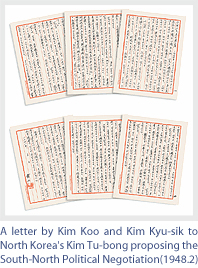
South-North Political Negotiation
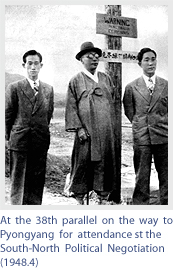 Determined to realize a unified government for both the South and North, Kim Koo issued a strong statement of opposition to the establishment of separate governments. In April 1948 Kim Koo visited North Korea with Kim Kyu-sik to discuss Korea's unification. Simultaneously, he demanded a total withdrawal from the Korean peninsula of all the armed forces of the super powers. Despite his earnest exhortations, the US Military Government in Korea carried out a South Korea's exclusive general election, and Kim Koo's life-long wish came to naught.
Determined to realize a unified government for both the South and North, Kim Koo issued a strong statement of opposition to the establishment of separate governments. In April 1948 Kim Koo visited North Korea with Kim Kyu-sik to discuss Korea's unification. Simultaneously, he demanded a total withdrawal from the Korean peninsula of all the armed forces of the super powers. Despite his earnest exhortations, the US Military Government in Korea carried out a South Korea's exclusive general election, and Kim Koo's life-long wish came to naught.
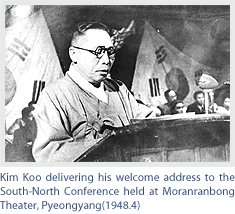
Unification Movement
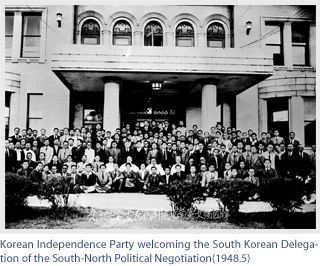 Before the South Korea's exclusive general election held on May 10, 1948, and North Korea's preparation for a general election, Kim Koo tried all possible means against the establishment of separate governments of South and North. In July of the same year, Kim Koo organized the Association for National Unification Promotion under the slogan of accomplishment of national unification through converging national strength rather than following pro-US and pro-Russia policies. Even after the establishment of separate South-North governments, Kim Koo never gave up his efforts to realize sovereign national unification.
Before the South Korea's exclusive general election held on May 10, 1948, and North Korea's preparation for a general election, Kim Koo tried all possible means against the establishment of separate governments of South and North. In July of the same year, Kim Koo organized the Association for National Unification Promotion under the slogan of accomplishment of national unification through converging national strength rather than following pro-US and pro-Russia policies. Even after the establishment of separate South-North governments, Kim Koo never gave up his efforts to realize sovereign national unification.
Cultivating Men of Talent
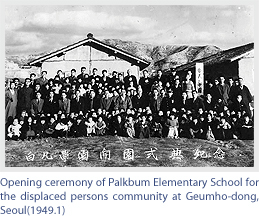 After returning to Korea in November 1945, Kim Koo continued to work for equal opportunity to education in the new democratic country. In order to cultivate capable young men he opened the Nation-Building School in March 1947, the Paikbum Academy in January 1949, and the Changam Academy in March 1949.
After returning to Korea in November 1945, Kim Koo continued to work for equal opportunity to education in the new democratic country. In order to cultivate capable young men he opened the Nation-Building School in March 1947, the Paikbum Academy in January 1949, and the Changam Academy in March 1949.
